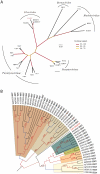Discovery of an ebolavirus-like filovirus in europe
- PMID: 22039362
- PMCID: PMC3197594
- DOI: 10.1371/journal.ppat.1002304
Discovery of an ebolavirus-like filovirus in europe
Abstract
Filoviruses, amongst the most lethal of primate pathogens, have only been reported as natural infections in sub-Saharan Africa and the Philippines. Infections of bats with the ebolaviruses and marburgviruses do not appear to be associated with disease. Here we report identification in dead insectivorous bats of a genetically distinct filovirus, provisionally named Lloviu virus, after the site of detection, Cueva del Lloviu, in Spain.
Conflict of interest statement
Stephen Hutchison is an employee at 454 Life Sciences, a division of Roche Inc.
Figures



Similar articles
-
Accounting for population structure reveals ambiguity in the Zaire Ebolavirus reservoir dynamics.PLoS Negl Trop Dis. 2020 Mar 4;14(3):e0008117. doi: 10.1371/journal.pntd.0008117. eCollection 2020 Mar. PLoS Negl Trop Dis. 2020. PMID: 32130210 Free PMC article.
-
Experimental Inoculation of Egyptian Rousette Bats (Rousettus aegyptiacus) with Viruses of the Ebolavirus and Marburgvirus Genera.Viruses. 2015 Jun 25;7(7):3420-42. doi: 10.3390/v7072779. Viruses. 2015. PMID: 26120867 Free PMC article.
-
Ebola Virus Maintenance: If Not (Only) Bats, What Else?Viruses. 2018 Oct 9;10(10):549. doi: 10.3390/v10100549. Viruses. 2018. PMID: 30304789 Free PMC article. Review.
-
Ebola Virus Field Sample Collection.Methods Mol Biol. 2017;1628:373-393. doi: 10.1007/978-1-4939-7116-9_30. Methods Mol Biol. 2017. PMID: 28573636
-
Ebolavirus and other filoviruses.Curr Top Microbiol Immunol. 2007;315:363-87. doi: 10.1007/978-3-540-70962-6_15. Curr Top Microbiol Immunol. 2007. PMID: 17848072 Free PMC article. Review.
Cited by
-
Bayesian mixture analysis for metagenomic community profiling.Bioinformatics. 2015 Sep 15;31(18):2930-8. doi: 10.1093/bioinformatics/btv317. Epub 2015 May 21. Bioinformatics. 2015. PMID: 26002885 Free PMC article.
-
Ebola virus antibodies in fruit bats, Ghana, West Africa.Emerg Infect Dis. 2012 Jul;18(7):1207-9. doi: 10.3201/eid1807.111654. Emerg Infect Dis. 2012. PMID: 22710257 Free PMC article. No abstract available.
-
Detection of anti-ebolavirus antibodies in Ghanaian pigs.J Vet Med Sci. 2022 Nov 1;84(11):1491-1494. doi: 10.1292/jvms.22-0186. Epub 2022 Sep 20. J Vet Med Sci. 2022. PMID: 36123040 Free PMC article.
-
Detecting remote sequence homology in disordered proteins: discovery of conserved motifs in the N-termini of Mononegavirales phosphoproteins.PLoS One. 2012;7(3):e31719. doi: 10.1371/journal.pone.0031719. Epub 2012 Mar 5. PLoS One. 2012. PMID: 22403617 Free PMC article.
-
Biodefense Oriented Genomic-Based Pathogen Classification Systems: Challenges and Opportunities.J Bioterror Biodef. 2012 Mar 16;3(1):1000113. doi: 10.4172/2157-2526.1000113. J Bioterror Biodef. 2012. PMID: 25587492 Free PMC article.
References
-
- Barrette RW, Metwally SA, Rowland JM, Xu L, Zaki SR, et al. Discovery of swine as a host for the Reston ebolavirus. Science. 2009;325:204–206. - PubMed
-
- Leroy EM, Epelboin A, Mondonge V, Pourrut X, Gonzalez JP, et al. Human Ebola outbreak resulting from direct exposure to fruit bats in Luebo, Democratic Republic of Congo, 2007. Vector Borne Zoonotic Dis. 2009;9:723–728. - PubMed
-
- Leroy EM, Kumulungui B, Pourrut X, Rouquet P, Hassanin A, et al. Fruit bats as reservoirs of Ebola virus. Nature. 2005;438:575–576. - PubMed
Publication types
MeSH terms
Substances
Grants and funding
LinkOut - more resources
Full Text Sources
Medical
Molecular Biology Databases

